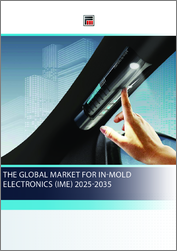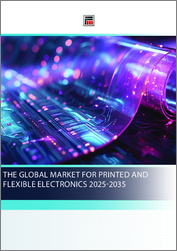
|
시장보고서
상품코드
1541715
세계의 프린티드 일렉트로닉스 시장 보고서 : 재료, 기술, 디바이스, 지역별(2024-2032년)Printed Electronics Market Report by Material (Ink, Substrate), Technology (Inkjet, Screen, Gravure, Flexographic), Device (Display, Photovoltaic, Lighting, RFID, and Others), and Region 2024-2032 |
||||||
세계의 프린티드 일렉트로닉스 시장 규모는 2023년 727억 달러에 달했습니다. 향후 IMARC Group은 2032년에는 2,372억 달러에 이를 전망이고, 예측 기간 동안 13.6%의 복합 연간 성장률(CAGR)을 나타낼 것으로 예측했습니다.
프린티드 일렉트로닉스는 탄소 기반 복합 잉크, 잉크젯 프린터, 플렉소 인쇄, 그라비아 인쇄, 스크린 인쇄 기술을 사용하여 호일, 종이, 유리, 패브릭 폴리머 등의 기판 위에 개발된 전자 장치를 말합니다. 일반적으로 사용되는 프린티드 일렉트로닉스는 웨어러블 디바이스, 연질 키보드, 전자 피부 패치, 바이오 센서, 디스플레이 유닛, 유기 LED(OLED), 광전지 등을 포함합니다. 기존에 사용되고 있는 전자기기에 비해, 프린티드 바리에이션은 환경 친화적이고, 경량, 유연성이 있고, 비용 효율이 높고, 필요한 전력이 적습니다. 그 결과 항공우주, 자동차, 의료, 소비자용 전자기기 등 다양한 산업에서 폭넓게 응용되고 있습니다.
세계의 프린티드 일렉트로닉스 시장 동향
세계의 전자 산업의 현저한 성장은 시장 전망을 밝게 하는 중요한 요소 중 하나입니다. 차세대 연질 제품에 대한 요구가 높아지는 가운데 에너지 효율이 높고, 얇고 지속 가능한 소비자용 전자 기기에 대한 수요가 높아지고 있습니다. 게다가 스마트 디바이스와 커넥티드 디바이스의 보급이 시장의 성장을 뒷받침하고 있습니다. 웨어러블 기기, 스마트 패키징 솔루션, 의료기기, 스마트 의류 등에서는 센싱, 데이터 보존, 전송에 유리한 특성을 가지는 프린티드 일렉트로닉스에 대한 소비자의 취향이 변화하고 있습니다. 또한 Additive Manufacturing과 Screen Printing 기술의 활용 등 다양한 기술 혁신이 다른 성장 촉진요인으로 작용하고 있습니다. 이러한 기술은 자외선(UV) 경화성 잉크, 플라스티졸 잉크, 수성 잉크 및 솔벤트 기반 잉크를 사용하여 정밀도를 높이는 완전한 전기 기계 부품을 제조하는 데 도움이 됩니다. 이에 따라 프린트 센서와 패널은 항공기 및 군용 차량의 조종석 및 내비게이션 시스템에도 널리 사용되고 있으며 시장 성장을 뒷받침하고 있습니다.
이 보고서에서 다루는 주요 질문
- 2023년 세계의 프린티드 일렉트로닉스 시장 규모는?
- 예측 기간 동안 프린티드 일렉트로닉스 시장 시장 성장률은?
- 세계의 프린티드 일렉트로닉스 시장을 견인하는 주요인은 무엇인가?
- 세계의 프린티드 일렉트로닉스 시장에 대한 COVID-19의 영향은?
- 세계의 프린티드 일렉트로닉스 시장의 재료별 내역은?
- 세계의 프린티드 일렉트로닉스 시장의 기술별 내역은?
- 세계의 프린티드 일렉트로닉스 시장의 디바이스별 내역은?
- 프린티드 일렉트로닉스 시장의 세계의 주요 지역은?
- 프린티드 일렉트로닉스 시장의 주요 진출기업은?
목차
제1장 서문
제2장 조사 범위와 조사 방법
- 조사의 목적
- 이해관계자
- 데이터 소스
- 1차 정보
- 2차 정보
- 시장 추정
- 상향식 접근
- 하향식 접근
- 조사 방법
제3장 주요 요약
제4장 소개
- 개요
- 주요 업계 동향
제5장 세계의 프린티드 일렉트로닉스 시장
- 시장 개요
- 시장 실적
- COVID-19의 영향
- 시장 예측
제6장 시장 분석 : 재료별
- 잉크
- 기판
제7장 시장 분석 : 기술별
- 잉크젯
- 스크린
- 그라비어 인쇄
- 플렉소 인쇄
제8장 시장 분석 : 디바이스별
- 스크린
- 태양광 발전
- 조명
- RFID
- 기타
제9장 시장 분석 : 지역별
- 북미
- 미국
- 캐나다
- 아시아태평양
- 중국
- 일본
- 인도
- 한국
- 호주
- 인도네시아
- 기타
- 유럽
- 독일
- 프랑스
- 영국
- 이탈리아
- 스페인
- 러시아
- 기타
- 라틴아메리카
- 브라질
- 멕시코
- 기타
- 중동 및 아프리카
- 시장 동향
- 시장 분석 : 국가별
- 시장 예측
제10장 SWOT 분석
- 개요
- 강점
- 약점
- 기회
- 위협
제11장 밸류체인 분석
제12장 Porter's Five Forces 분석
- 개요
- 구매자의 협상력
- 공급기업의 협상력
- 경쟁도
- 신규 참가업체의 위협
- 대체품의 위협
제13장 가격 분석
제14장 경쟁 구도
- 시장 구조
- 주요 기업
- 주요 기업 프로파일
- Agfa-Gevaert NV
- BASF SE
- DuPont de Nemours Inc.
- E Ink Holdings Inc.
- Molex LLC(Koch Industries)
- Nissha Co. Ltd.
- NovaCentrix
- Optomec Inc.
- Palo Alto Research Center Incorporated(Xerox Corporation)
- Vorbeck Materials Corporation
- Ynvisible Interactive Inc.
The global printed electronics market size reached US$ 72.7 Billion in 2023. Looking forward, IMARC Group expects the market to reach US$ 237.2 Billion by 2032, exhibiting a growth rate (CAGR) of 13.6% during 2024-2032.
Printed electronics refer to the electronic devices developed on substrates, such as foil, paper, glass and fabric polymers, using carbon-based compound inks, inkjet printers and flexography, gravure and screen-printing technologies. Some of the commonly used printed electronics include wearable devices, flexible keyboards, electronic skin patches, biosensors, display units, Organic Light Emitting Diode (OLEDs) and photovoltaic cells. In comparison to the traditionally used electronics, printed variants are more environment-friendly, lightweight, flexible, cost-effective and have lower power requirements. As a result, they find extensive application across various industries, such as aerospace, automotive, healthcare and consumer electronics.
Global Printed Electronics Market Trends:
Significant growth in the electronic industry across the globe is one of the key factors creating a positive outlook for the market. With the increasing requirement for next-generation flexible products, there is a rising demand for energy-efficient, thin and sustainable consumer electronics. Moreover, the widespread adoption of smart and connected devices is providing a thrust to the market growth. There is a shifting consumer preference for printed electronics in wearable devices, smart packaging solutions, medical devices and smart apparels due to the favorable sensing, data storage and transmission properties. Additionally, various innovations, such as the utilization of additive manufacturing and screen-printing technologies, are acting as other growth-inducing factors. They aid in producing fully electromechanical components with enhanced accuracy using ultraviolet (UV) curable, plastisol, water and solvent-based inks. In line with this, printed sensors and panels are also extensively used in the cockpits and navigation systems of aircraft and military vehicles, thereby favoring the market growth.
Key Market Segmentation:
IMARC Group provides an analysis of the key trends in each sub-segment of the global printed electronics market report, along with forecasts at the global, regional and country level from 2024-2032. Our report has categorized the market based on material, technology and device.
Breakup by Material:
Ink
Substrate
Breakup by Technology:
Inkjet
Screen
Gravure
Flexographic
Breakup by Device:
Display
Photovoltaic
Lighting
RFID
Others
Breakup by Region:
North America
United States
Canada
Asia-Pacific
China
Japan
India
South Korea
Australia
Indonesia
Others
Europe
Germany
France
United Kingdom
Italy
Spain
Russia
Others
Latin America
Brazil
Mexico
Others
Middle East and Africa
Competitive Landscape:
The competitive landscape of the industry has also been examined along with the profiles of the key players being Agfa-Gevaert N.V., BASF SE, DuPont de Nemours Inc., E Ink Holdings Inc., Molex LLC (Koch Industries), Nissha Co. Ltd., NovaCentrix, Optomec Inc., Palo Alto Research Center Incorporated (Xerox Corporation), Vorbeck Materials Corporation and Ynvisible Interactive Inc.
Key Questions Answered in This Report
- 1. What was the size of the global printed electronics market in 2023?
- 2. What is the expected growth rate of the global printed electronics market during 2024-2032?
- 3. What are the key factors driving the global printed electronics market?
- 4. What has been the impact of COVID-19 on the global printed electronics market?
- 5. What is the breakup of the global printed electronics market based on the material?
- 6. What is the breakup of the global printed electronics market based on the technology?
- 7. What is the breakup of the global printed electronics market based on device?
- 8. What are the key regions in the global printed electronics market?
- 9. Who are the key players/companies in the global printed electronics market?
Table of Contents
1 Preface
2 Scope and Methodology
- 2.1 Objectives of the Study
- 2.2 Stakeholders
- 2.3 Data Sources
- 2.3.1 Primary Sources
- 2.3.2 Secondary Sources
- 2.4 Market Estimation
- 2.4.1 Bottom-Up Approach
- 2.4.2 Top-Down Approach
- 2.5 Forecasting Methodology
3 Executive Summary
4 Introduction
- 4.1 Overview
- 4.2 Key Industry Trends
5 Global Printed Electronics Market
- 5.1 Market Overview
- 5.2 Market Performance
- 5.3 Impact of COVID-19
- 5.4 Market Forecast
6 Market Breakup by Material
- 6.1 Ink
- 6.1.1 Market Trends
- 6.1.2 Market Forecast
- 6.2 Substrate
- 6.2.1 Market Trends
- 6.2.2 Market Forecast
7 Market Breakup by Technology
- 7.1 Inkjet
- 7.1.1 Market Trends
- 7.1.2 Market Forecast
- 7.2 Screen
- 7.2.1 Market Trends
- 7.2.2 Market Forecast
- 7.3 Gravure
- 7.3.1 Market Trends
- 7.3.2 Market Forecast
- 7.4 Flexographic
- 7.4.1 Market Trends
- 7.4.2 Market Forecast
8 Market Breakup by Device
- 8.1 Display
- 8.1.1 Market Trends
- 8.1.2 Market Forecast
- 8.2 Photovoltaic
- 8.2.1 Market Trends
- 8.2.2 Market Forecast
- 8.3 Lighting
- 8.3.1 Market Trends
- 8.3.2 Market Forecast
- 8.4 RFID
- 8.4.1 Market Trends
- 8.4.2 Market Forecast
- 8.5 Others
- 8.5.1 Market Trends
- 8.5.2 Market Forecast
9 Market Breakup by Region
- 9.1 North America
- 9.1.1 United States
- 9.1.1.1 Market Trends
- 9.1.1.2 Market Forecast
- 9.1.2 Canada
- 9.1.2.1 Market Trends
- 9.1.2.2 Market Forecast
- 9.1.1 United States
- 9.2 Asia-Pacific
- 9.2.1 China
- 9.2.1.1 Market Trends
- 9.2.1.2 Market Forecast
- 9.2.2 Japan
- 9.2.2.1 Market Trends
- 9.2.2.2 Market Forecast
- 9.2.3 India
- 9.2.3.1 Market Trends
- 9.2.3.2 Market Forecast
- 9.2.4 South Korea
- 9.2.4.1 Market Trends
- 9.2.4.2 Market Forecast
- 9.2.5 Australia
- 9.2.5.1 Market Trends
- 9.2.5.2 Market Forecast
- 9.2.6 Indonesia
- 9.2.6.1 Market Trends
- 9.2.6.2 Market Forecast
- 9.2.7 Others
- 9.2.7.1 Market Trends
- 9.2.7.2 Market Forecast
- 9.2.1 China
- 9.3 Europe
- 9.3.1 Germany
- 9.3.1.1 Market Trends
- 9.3.1.2 Market Forecast
- 9.3.2 France
- 9.3.2.1 Market Trends
- 9.3.2.2 Market Forecast
- 9.3.3 United Kingdom
- 9.3.3.1 Market Trends
- 9.3.3.2 Market Forecast
- 9.3.4 Italy
- 9.3.4.1 Market Trends
- 9.3.4.2 Market Forecast
- 9.3.5 Spain
- 9.3.5.1 Market Trends
- 9.3.5.2 Market Forecast
- 9.3.6 Russia
- 9.3.6.1 Market Trends
- 9.3.6.2 Market Forecast
- 9.3.7 Others
- 9.3.7.1 Market Trends
- 9.3.7.2 Market Forecast
- 9.3.1 Germany
- 9.4 Latin America
- 9.4.1 Brazil
- 9.4.1.1 Market Trends
- 9.4.1.2 Market Forecast
- 9.4.2 Mexico
- 9.4.2.1 Market Trends
- 9.4.2.2 Market Forecast
- 9.4.3 Others
- 9.4.3.1 Market Trends
- 9.4.3.2 Market Forecast
- 9.4.1 Brazil
- 9.5 Middle East and Africa
- 9.5.1 Market Trends
- 9.5.2 Market Breakup by Country
- 9.5.3 Market Forecast
10 SWOT Analysis
- 10.1 Overview
- 10.2 Strengths
- 10.3 Weaknesses
- 10.4 Opportunities
- 10.5 Threats
11 Value Chain Analysis
12 Porters Five Forces Analysis
- 12.1 Overview
- 12.2 Bargaining Power of Buyers
- 12.3 Bargaining Power of Suppliers
- 12.4 Degree of Competition
- 12.5 Threat of New Entrants
- 12.6 Threat of Substitutes
13 Price Analysis
14 Competitive Landscape
- 14.1 Market Structure
- 14.2 Key Players
- 14.3 Profiles of Key Players
- 14.3.1 Agfa-Gevaert N.V.
- 14.3.1.1 Company Overview
- 14.3.1.2 Product Portfolio
- 14.3.1.3 Financials
- 14.3.1.4 SWOT Analysis
- 14.3.2 BASF SE
- 14.3.2.1 Company Overview
- 14.3.2.2 Product Portfolio
- 14.3.2.3 Financials
- 14.3.2.4 SWOT Analysis
- 14.3.3 DuPont de Nemours Inc.
- 14.3.3.1 Company Overview
- 14.3.3.2 Product Portfolio
- 14.3.3.3 Financials
- 14.3.3.4 SWOT Analysis
- 14.3.4 E Ink Holdings Inc.
- 14.3.4.1 Company Overview
- 14.3.4.2 Product Portfolio
- 14.3.4.3 Financials
- 14.3.5 Molex LLC (Koch Industries)
- 14.3.5.1 Company Overview
- 14.3.5.2 Product Portfolio
- 14.3.5.3 SWOT Analysis
- 14.3.6 Nissha Co. Ltd.
- 14.3.6.1 Company Overview
- 14.3.6.2 Product Portfolio
- 14.3.6.3 Financials
- 14.3.7 NovaCentrix
- 14.3.7.1 Company Overview
- 14.3.7.2 Product Portfolio
- 14.3.8 Optomec Inc.
- 14.3.8.1 Company Overview
- 14.3.8.2 Product Portfolio
- 14.3.9 Palo Alto Research Center Incorporated (Xerox Corporation)
- 14.3.9.1 Company Overview
- 14.3.9.2 Product Portfolio
- 14.3.10 Vorbeck Materials Corporation
- 14.3.10.1 Company Overview
- 14.3.10.2 Product Portfolio
- 14.3.11 Ynvisible Interactive Inc.
- 14.3.11.1 Company Overview
- 14.3.11.2 Product Portfolio
- 14.3.11.3 Financials
- 14.3.1 Agfa-Gevaert N.V.



















